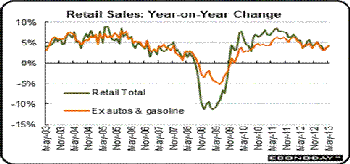Popular Economics Weekly
There are signs that economists have underestimated GDP growth this year. The New York Times surveyed economists in a recent Sunday front page article, that said growth could increase to 3 percent from the 2 percent norm of the past 3 years. “That is the surprising new view of a number of economists in academia and on Wall Street, who are now predicting something the United States has not experienced in years: healthier, more lasting growth,” said the Nicholas D. Schwartz article.
And consumers are spending more. May retail sales surprised on the upside and increased 0.6 percent on the month and were up 4.3 percent from a year ago. Retail sales excluding just autos and excluding both autos and gasoline were up 0.3 percent from April, much as expected. On the year, they were up 2.8 percent and 4.1 percent respectively.
Graph: Econoday
This is reflected in consumer confidence numbers. Consumer sentiment has been oscillating upward slowly since the mid-2011 plunge. Consumer spirits have been on a climb the last couple of months, but dipped back mid-June to 82.7 versus May's 84.5.
The consumer's fundamental outlook for the economy is little changed with the expectations component rising nearly 1 point to 76.7 which is near a recovery high. In fact, the current conditions outlook is almost back to 2006 levels.
The nonpartisan Congressional Budget Office also sees relatively fast growth of 3.4 percent next year, and 3.6 percent between 2015 and 2018. A few other private economists are even more bullish, according to the New York Times article. Jim Glassman, senior economist at JP Morgan Chase’s commercial bank, estimates the economy could expand by 4 percent in both 2014 and 2015. If that were to come to pass, it would be the strongest back-to-back annual growth since the late 1990s.
There are many ingredients that could boost economic growth. The U.S. could become a net exporter of oil and gas in the coming decades. Health care costs are declining thanks to Obamacare, or the Affordable Care Act, according to many analysts. And housing may now be leading the recovery, while household net worth has increased some $3 trillion in Q1 2013, according to the Federal Reserve’s Flow of Funds report.
In fact, household debt continues to decline, also making consumers more optimistic about their future. The Calculated Risk graph shows the Debt to Service Ratio for both renters and homeowners (red), and the homeowner financial obligations ratio for mortgages (blue) and consumer debt (yellow).
Almost all of the ratios are down to levels that prevailed in the1990s (graph begins in 1980). This is both because of historically low interest rates, rates that we haven’t seen since World War II, and the large number of foreclosures and short sales that have reduced mortgage debt by as much as one-third in some regions.
That tells us the importance of low interest rates during this recovery, when household incomes are still stagnant, mainly due to almost no growth in wages and salaries—the income earned by most households (therefore consumers).
In fact, real, after inflation household incomes have declined 7.8 percent since the end of the Great Recession, which is the ‘real’ reason this recovery has been so painfully slow.
As Doug Short says in his excellent blog column, “The stunning reality illustrated here is that the real median household income series spent most of the first nine years of the 21st century struggling slightly below its purchasing power at the turn of the century.”
Harlan Green © 2013
Follow Harlan Green on Twitter: www.twitter.com/HarlanGreen




No comments:
Post a Comment